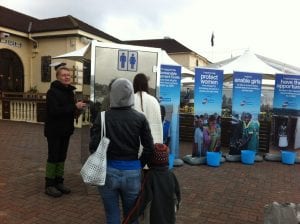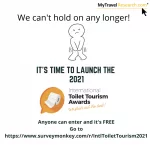Every year I love reading about the Ig Nobel Award. This is an international science award that every year recognises a great truth about humans. If we can make an emotional connection to an issue, we are more likely to do something about it. The idea of the award is to recognise science that ‘first makes you laugh and then makes you think’.
The same is true of #toilettourism: the impact that toilets can have on the visitation of a place. Whenever we talk about it – including when Bron published her piece last year on the subject – people laugh. Then their face changes and they nod sagely. The next comment is almost always some variant of ‘you’re absolutely right’.
So #toilettourism is a serious business.
We were reminded of this when we were invited to the launch of #looview on the promenade at Bondi. This was a pop-up ‘see through loo’. It was developed by UNICEF to showcase a partnership they have developed with hygiene brand Domestos to provide access to proper toilets for 25 million people in developing countries by 2020. This is an amazing number, but it’s a big mountain to climb: more than 2.5 billion people worldwide (or around 1 in 3 people) don’t have access to a proper toilet.
The pop-up tries to give Australians a sense of using a toilet where there is no privacy. You can’t see into the toilet at all (see the image to the left). But if you go inside, you can see out. Such is the power of this visual effect that if you sit in the booth you really do feel exposed. To see more, click on the video below (this shows it in another location as the video with me is no longer available.
The stand was so mobbed over the weekend that it was on the show that they didn’t actually manage to get precise visitor numbers. This is bearing in mind it was a cold and wet weekend in Bondi in Australia’s winter. But over 3 days, they engaged at least 200 people to help them understand which of the messages that the pop-up was trying to convey was most engaging. It is likely therefore that over 3 days at least four times as many people saw and discussed it. Our social media post on the subject reached at least 5 times as many people as our previous highest one. That’s the power of #toilettourism in action. Imagine that effect applied to your destination, product or experience.

Why we love this idea
We also really love this pop-up for two other reasons. It’s a smart example of partnership marketing and a really engaging way to get a complex message across.
Too often sponsorships, particularly those with a corporate social responsibility angle, can feel very contrived. But Domestos’ brand values and purpose actually align perfectly with those of Unicef on this project. So the partnership has great credibility on both sides. And their reach and profile can put this issue in front of many more people than even the best-funded charity. Domestos promotes the partnership with its audience and donates a share of the proceeds of each bottle of Domestos sold. So far they have given more than 655,000 people access to a safe toilet and overall reached/educated more than 1 million people. That’s a great piece of learning for us in the tourism industry as we try to find our partners to engage with the visitor economy.
As Bron noted in her blog place, there’s an even more important issue at stake. Good toilets can literally change the world: globally poor hygiene kills 2,000 kids under 5 each day and is directly linked to this issue; lack of access to toilets puts women in developing countries at risk of sexual violence and causes them to drop out of education. But trying to get that message across in a cluttered media environment with so many causes competing for your attention. #looview got us talking about all of those things in a more effective way than the biggest and most expensive TVC could have done.
There isn’t an Ig Nobel for marketing, but I reckon if there was this initiative would be up there for an award. Because it really did first make us laugh and then it made us think. But more importantly, it then got us talking and showed us how to take action. Valuable lessons for us all in tourism





Leave a Reply